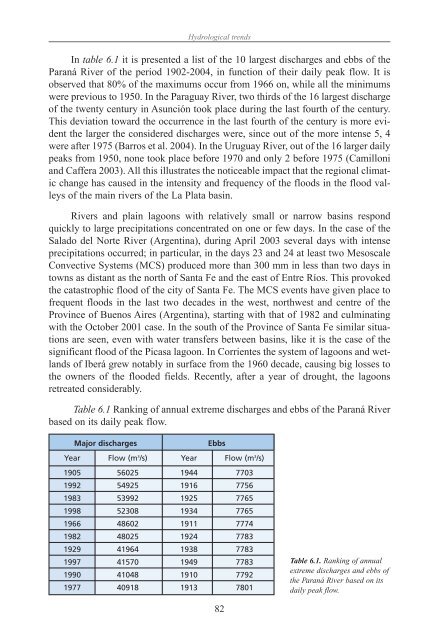chapter - Atmospheric and Oceanic Science
chapter - Atmospheric and Oceanic Science
chapter - Atmospheric and Oceanic Science
Create successful ePaper yourself
Turn your PDF publications into a flip-book with our unique Google optimized e-Paper software.
Hydrological trends<br />
In table 6.1 it is presented a list of the 10 largest discharges <strong>and</strong> ebbs of the<br />
Paraná River of the period 1902-2004, in function of their daily peak flow. It is<br />
observed that 80% of the maximums occur from 1966 on, while all the minimums<br />
were previous to 1950. In the Paraguay River, two thirds of the 16 largest discharge<br />
of the twenty century in Asunción took place during the last fourth of the century.<br />
This deviation toward the occurrence in the last fourth of the century is more evident<br />
the larger the considered discharges were, since out of the more intense 5, 4<br />
were after 1975 (Barros et al. 2004). In the Uruguay River, out of the 16 larger daily<br />
peaks from 1950, none took place before 1970 <strong>and</strong> only 2 before 1975 (Camilloni<br />
<strong>and</strong> Caffera 2003). All this illustrates the noticeable impact that the regional climatic<br />
change has caused in the intensity <strong>and</strong> frequency of the floods in the flood valleys<br />
of the main rivers of the La Plata basin.<br />
Rivers <strong>and</strong> plain lagoons with relatively small or narrow basins respond<br />
quickly to large precipitations concentrated on one or few days. In the case of the<br />
Salado del Norte River (Argentina), during April 2003 several days with intense<br />
precipitations occurred; in particular, in the days 23 <strong>and</strong> 24 at least two Mesoscale<br />
Convective Systems (MCS) produced more than 300 mm in less than two days in<br />
towns as distant as the north of Santa Fe <strong>and</strong> the east of Entre Ríos. This provoked<br />
the catastrophic flood of the city of Santa Fe. The MCS events have given place to<br />
frequent floods in the last two decades in the west, northwest <strong>and</strong> centre of the<br />
Province of Buenos Aires (Argentina), starting with that of 1982 <strong>and</strong> culminating<br />
with the October 2001 case. In the south of the Province of Santa Fe similar situations<br />
are seen, even with water transfers between basins, like it is the case of the<br />
significant flood of the Picasa lagoon. In Corrientes the system of lagoons <strong>and</strong> wetl<strong>and</strong>s<br />
of Iberá grew notably in surface from the 1960 decade, causing big losses to<br />
the owners of the flooded fields. Recently, after a year of drought, the lagoons<br />
retreated considerably.<br />
Table 6.1 Ranking of annual extreme discharges <strong>and</strong> ebbs of the Paraná River<br />
based on its daily peak flow.<br />
Major discharges Ebbs<br />
Year Flow (m 3 /s) Year Flow (m 3 /s)<br />
1905 56025 1944 7703<br />
1992 54925 1916 7756<br />
1983 53992 1925 7765<br />
1998 52308 1934 7765<br />
1966 48602 1911 7774<br />
1982 48025 1924 7783<br />
1929 41964 1938 7783<br />
1997 41570 1949 7783<br />
1990 41048 1910 7792<br />
1977 40918 1913 7801<br />
82<br />
Table 6.1. Ranking of annual<br />
extreme discharges <strong>and</strong> ebbs of<br />
the Paraná River based on its<br />
daily peak flow.






